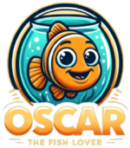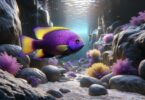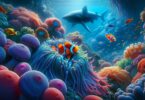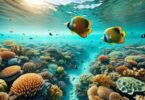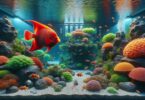Saddle clownfish, a name that conjures images of vibrant underwater worlds, are among the most fascinating creatures of the ocean. With their distinctive markings and playful demeanor, they’ve captured the hearts of marine enthusiasts and aquarium hobbyists alike.
Diving into the world of saddle clownfish, I’ve discovered a realm filled with intriguing behaviors and a surprising adaptability. These fish aren’t just a visual treat; they’re a testament to the wonders of marine life. Join me as we explore the captivating world of saddle clownfish, a journey that promises to be as enlightening as it is enchanting.
Anatomy of a Saddle Clownfish
Discovering the anatomy of a saddle clownfish is like unveiling the blueprint of their vibrant existence in the marine world. As I delve deeper, I understand their appearance isn’t just about aesthetics but also about survival and adaptation. Saddle clownfish, named for the distinctive saddle-like mark on their back, showcase a remarkable design that sets them apart from other saltwater fish.
Their bodies are robust and oval-shaped, designed to swiftly navigate through the intricate structures of coral reefs. The unique color patterns, combining bold oranges, whites, and blacks, aren’t just for show. They play a crucial role in camouflaging and warding off predators, demonstrating an incredible symbiosis with their habitat. The mix of colors and patterns varies significantly across individuals, making each fish a unique sight in the aquarium.
When it comes to setting up an aquarium for saddle clownfish, understanding their natural environment is key. These fish thrive in saltwater tanks that mimic the complexity and richness of coral reefs. Starting your aquarium with the right aquarium equipment is essential. A stable aquarium heater and an efficient fish tank filter ensure a clean and suitable environment. Additionally, the aquarium light is not just for highlighting the vibrant colors of the clownfish but also for supporting the life of corals they may share the space with.
Moreover, the water quality cannot be overlooked. Using a water conditioner for fish tank helps in removing harmful chemicals and making the water safe for the inhabitants. Given their adaptable nature, saddle clownfish do well in various aquarium tank sizes, but as a rule of thumb, bigger often means better when it comes to providing a spacious and enriching environment.
Exploring the anatomy and needs of saddle clownfish has deepened my admiration for these fascinating creatures. They’re not just another fish; they’re a testament to the wonders of marine life and the importance of creating a harmonious aquarium setup that respects their natural needs.
Habitat and Distribution
Saddle clownfish, a marvel of the ocean, have a unique habitat that’s fascinating to learn about. I’ve delved deep into understanding where these colorful creatures call home and the environment they thrive in. Their habitat is primarily in the warm, shallow waters of the Western Pacific, extending from the coast of Northwest Australia to Southeast Asia and Japan. This distribution plays a crucial role in the setup of an aquarium intended for saddle clownfish.
One might wonder, what makes their natural habitat so special? Well, these fish are commonly found in lagoons and outer reefs where the water is clear, and there’s an abundance of coral for hiding and breeding. The symbiotic relationship between saddle clownfish and anemones is noteworthy. They reside in the tentacles of anemones, gaining protection from predators while benefiting their host by providing nutrients through the waste they produce.
When Starting Your Aquarium, it’s essential to mirror their natural habitat to ensure their health and happiness. This includes the right Aquarium Tank Size, which should be no less than 30 gallons to provide ample space for swimming and hiding. Implementing an effective Fish Tank Filter and Aquarium Heater is non-negotiable, as these mimic the clean, warm waters saddle clownfish are accustomed to.
Additionally, incorporating a Water Conditioner for Fish Tank is critical to eliminate harmful chemicals from tap water, creating a safe environment that resembles their oceanic home. While we might not replicate the exact oceanic conditions, understanding the importance of these factors helps in creating a suitable and harmonious aquarium setup for these delightful marine creatures.
Their adaptability and resilience make saddle clownfish a favorite among saltwater aquarium enthusiasts. However, their well-being heavily depends on our ability to replicate the conditions of their natural habitat as closely as possible.
Reproduction and Life Cycle
Understanding the Reproduction and Life Cycle of saddle clownfish is not just interesting, it’s crucial for those of us passionate about keeping these vibrant creatures in our aquariums. Saddle clownfish are known for their unique breeding behaviors and lifecycle, which can offer a fascinating glimpse into the complexity of marine life.
Saddle clownfish are protandrous hermaphrodites, meaning they are born male, with the potential to turn female later in life. This fascinating aspect of their biology is crucial for maintaining a balanced population, especially in the confines of an aquarium. When starting your aquarium, it’s important to consider the social structure of these fish, as their hierarchy directly influences their breeding and social interactions.
In the wild, these fish form monogamous pairs and exhibit a strong bond with their chosen mate. The breeding process typically begins with the pair performing a delicate dance around their chosen nesting site, usually a flat surface close to or within their host anemone. After spawning, the male takes on the responsibility of guarding the eggs, oxygenating them by fanning his fins, and removing any that become infested with fungus.
| Stage | Duration |
|---|---|
| Egg | 6-7 Days |
| Hatching | Night Time |
| Larval Stage | 8-12 Days |
| Juvenile Stage | 1-2 Months |
This transition from egg to fry is a critical time for saddle clownfish. Maintaining optimal water quality with a reliable aquarium filter and water conditioner for fish tanks is paramount. The right aquarium setup, including an appropriately sized tank and stable water conditions, supported by a capable aquarium light and heater, can significantly impact the survival rate of the fry.
Saddle clownfish fry are exceptionally tiny and require specialized care, including feeding on rotifers or specially formulated fry food, to ensure they reach adulthood. Understanding the nutritional needs and ensuring the right feed can help support the growth and development of these young fish.
Social Behavior and Communication
In my journey through the fascinating world of marine life, I’ve been particularly intrigued by the social behavior and communication of saddle clownfish. These saltwater fish exhibit a complex social structure that is not only captivating but critical to understand for anyone planning an aquarium setup.
Saddle clownfish are known for their strong social bonds, often forming monogamous pairs that cooperate in feeding, breeding, and defending their territory. This is a crucial aspect to consider when determining your aquarium tank size, as providing ample space is essential for their well-being. In the confined environment of an aquarium, mimicking their natural habitat helps in fostering a healthy social structure.
Communication among saddle clownfish involves a fascinating array of sounds and body language. They utilize pops, clicks, and other noises to communicate, especially during breeding seasons or when defending their territory. Observing these interactions has taught me the importance of a well-considered aquarium setup, where the inclusion of anemones not only replicates their natural environment but also supports their complex social interactions.
Moreover, the positioning of aquarium equipment plays a pivotal role in their communication and social behavior. Strategically placing the fish tank filter, aquarium light, and aquarium heater can affect water flow, lighting, and temperature, respectively, creating an environment that closely resembles their natural reef habitat. This consideration is crucial for their overall health and the expression of natural behaviors.
Proper water quality is non-negotiable for these marine creatures. Utilizing a high-quality water conditioner for fish tank ensures the removal of harmful chemicals and improves water quality, facilitating better communication and social interaction among the saddle clownfish.
By understanding and replicating the natural social structure and communication patterns of saddle clownfish, I’ve been able to create a harmonious and thriving aquarium setup. It’s proven that a thoughtful approach to starting your aquarium with these magnificent creatures can lead to a fascinating and rewarding aquatic experience.
Unique Adaptations of Saddle Clownfish
When I’m considering which species to feature in my aquarium, I always look at what makes them stand out. Saddle clownfish, or as the science folks call them, Amphiprion polymnus, have a range of unique adaptations that fascinate me as an aquarist. Let’s dive into these extraordinary traits that not only define their resilience but also how they thrive in their natural habitats.
Firstly, their striking color pattern is not just for show. The bold black and white markings amidst their vibrant orange bodies serve as a warning to predators and a camouflage among the reefs and anemones they call home. What’s fascinating is how these colors and patterns can slightly change, depending on the specific environment they inhabit. This versatility is something I aim to replicate in my aquarium setup by choosing the right aquarium light settings that can mimic the natural light conditions of their habitats.
Moreover, saddle clownfish have developed a symbiotic relationship with sea anemones, a relationship that’s essential to replicate in an aquarium for their wellbeing. Their mucus-covered skin protects them from the stinging tentacles of the anemone, allowing them a safe haven from predators. For anyone Starting Their Aquarium with saddle clownfish, including a suitable sea anemone species and ensuring the Aquarium Tank Size allows for this symbiosis is critical. This relationship adds a layer of complexity and beauty to your tank, highlighting the importance of thorough research on Fish Profiles.
Their diet in the wild, consisting mainly of algae, zooplankton, and small crustaceans, also highlights the need for a varied diet to keep them healthy in an aquarium. I’ve found that a combination of high-quality fish flakes, supplemented with frozen or live food, mimics their natural diet well and keeps them in vibrant health.
Ensuring your Aquarium Equipment, like the Fish Tank Filter and Aquarium Heater, is set up correctly to maintain the ideal water conditions mimics their native warm, shallow reef waters. Remember, a Water Conditioner for Fish Tank is invaluable in keeping the water quality pristine, vital for the sensitive saddle clownfish.
With these adaptations in mind, I’ve tailored my aquarium conditions to closely resemble their natural environment. This not only supports their wellbeing but also showcases their unique beauty and behaviors as they interact with their surroundings, including their symbiotic partners.
Conclusion
Understanding the unique needs of saddle clownfish is key to creating a thriving aquarium environment that mirrors their natural habitat. By focusing on their specific requirements for light, companionship with sea anemones, and a diet rich in variety, I’ve found that these magnificent creatures not only survive but flourish in captivity. It’s about more than just the beauty they bring to our homes; it’s about respecting and replicating the intricate ecosystems they come from. So, if you’re considering adding saddle clownfish to your aquarium, remember it’s a commitment to their well-being. With the right care, they’ll be a captivating addition, bringing a slice of the ocean’s wonder into your space.
